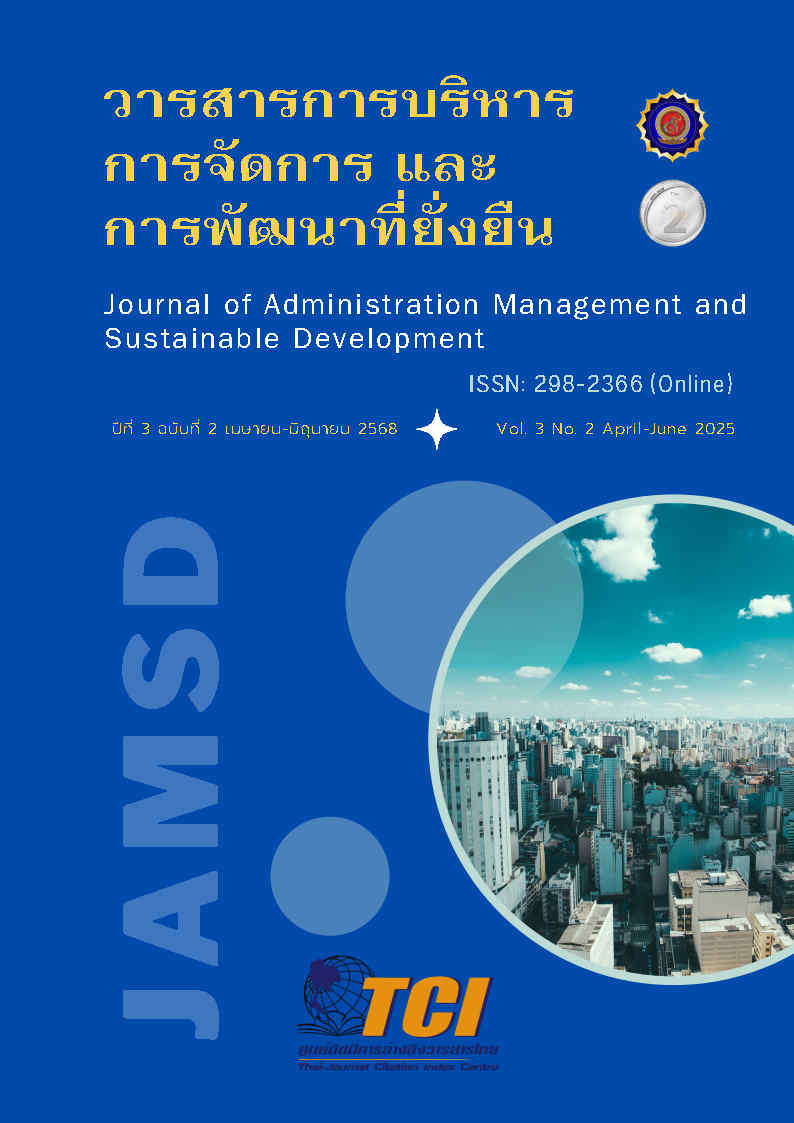การพัฒนาการเรียนรู้ของนิสิตนักศึกษาสาขาวิชาบัญชีในการตรวจสอบการควบคุมภายใน ผ่านตัวอย่างการเรียนรู้ที่มุ่งเน้นการปฏิบัติ
คำสำคัญ:
ความเชื่อมั่นในตนเอง, การเรียนรู้ที่มุ่งเน้นการปฏิบัติ, การตรวจสอบภายในบทคัดย่อ
การวิจัยนี้มีวัตถุประสงค์ 1. เพื่อศึกษาระดับความเชื่อมั่นในความสามารถของนิสิตนักศึกษาสาขาวิชาบัญชีในการปฏิบัติงานตรวจสอบภายในก่อนและหลังการเข้าร่วมกิจกรรมการเรียนรู้ที่มุ่งเน้นการปฏิบัติ (action-oriented learning task) และ 2. เพื่อศึกษาความคิดเห็นของนิสิตนักศึกษาที่เข้าร่วมกิจกรรมการเรียนรู้ที่มุ่งเน้นการปฏิบัติ โดยกิจกรรมการเรียนรู้นี้ได้รับการออกแบบโดยบูรณาการบทบาทของนิสิตในฐานะผู้ตรวจสอบภายในเข้ากับบริบทของสถานการณ์ทางธุรกิจจริงผ่านโครงการ KU smart young entrepreneurs เพื่อให้นิสิตนักศึกษาสาขาวิชาบัญชีมีโอกาสลงมือปฏิบัติงานตรวจสอบภายในจริงตามขั้นตอนหลัก ได้แก่ การวางแผนตรวจสอบ การดำเนินการตรวจสอบ และการสื่อสารผลการตรวจสอบ กลุ่มตัวอย่าง คือ นิสิตสาขาวิชาบัญชีที่ลงทะเบียนเรียนรายวิชาการกำกับดูแลกิจการและการตรวจสอบภายใน และเข้าร่วมกิจกรรมกับโครงการดังกล่าว การเก็บข้อมูลใช้แบบสอบถามก่อนและหลังการเข้าร่วมกิจกรรม และวิเคราะห์ผลด้วยสถิติ paired t-test ผลการวิจัยพบว่า ระดับความเชื่อมั่นในความสามารถของนิสิตเพิ่มขึ้นอย่างมีนัยสำคัญทางสถิติ (p < 0.01) ทั้งสามด้าน โดยเฉพาะในด้านการสื่อสารผลการตรวจสอบซึ่งมีค่าเฉลี่ยส่วนต่างสูงที่สุด และมีค่าดัชนีขนาดอิทธิพล (Cohen’s d) เท่ากับ 0.8178 ซึ่งอยู่ในระดับสูง นอกจากนี้ นิสิตนักศึกษามีความพึงพอใจในกิจกรรมการเรียนรู้ในระดับสูง และเห็นว่ากิจกรรมมีส่วนช่วยอย่างชัดเจนในการเตรียมความพร้อมสู่การทำงานในวิชาชีพบัญชี
เอกสารอ้างอิง
Anderson, U. L., Head, M. J., Mar, S., Ramamoorti, S., Riddle, C., Salamasick, M., & Sobel, P. J. (2022). Internal auditing: Assurance & advisory services (5th ed.). Institute of Internal Auditors.
Bandura, A. (1977). Self-efficacy: Toward a unifying theory of behavioral change. Psychological Review, 84(2), 191–215. https://doi.org/10.1037/0033-295X.84.2.191.
Beatson, N. J., Berg, D. A. G., & Smith, J. K. (2020). The influence of self‐efficacy beliefs and prior learning on performance. Accounting & Finance, 60(2), 1271–1294. https://doi.org/10.1111/acfi.12440.
Bureau of Academic Affairs and Educational Standards. (2020). Supervisory guidelines for enhancing and promoting active learning in alignment with the policy on "reducing classroom hours, increasing learning opportunities". Office of the Basic Education Commission. http://academic.obec.go.th/web/document/view/143.
Cohen, J. (1988). Statistical power analysis for the behavioral sciences (2nd ed.). Lawrence Erlbaum Associates.
Fowler, L. (2006). Active learning: An empirical study of the use of simulation games in the introductory financial accounting class. Academy of Educational Leadership Journal, 10(3), 93–103.
Hair, J. F., Black, W. C., Babin, B. J., & Anderson, R. E. (2019). Multivariate data analysis (8th ed.). Cengage Learning EMEA.
Holmes, A. F., & Rasmussen, S. J. (2018). Using Pinterest to stimulate student engagement, interest, and learning in managerial accounting courses. Journal of Accounting Education, 43, 43–56. https://doi.org/10.1016/j.jaccedu.2018.03.001
Hurtt, R. K. (2010). Development of a scale to measure professional skepticism. Auditing: A Journal of Practice & Theory, 29(1), 149–171. https://doi.org/10.2308/aud.2010.29.1.149.
Kern, B. B. (2002). Enhancing accounting students' problem-solving skills: The use of a hands-on conceptual model in an active learning environment. Accounting Education, 11(3), 235–256. https://doi.org/10.1080/09639280210141680.
Kolb, D. A. (1984). Experiential learning: Experience as the source of learning and development. Prentice-Hall.
Nelson, M. W. (2009). A model and literature review of professional skepticism in auditing. Auditing: A Journal of Practice & Theory, 28(2), 1–34. https://doi.org/10.2308/aud.2009.28.2.1.
OECD. (2023). G20/OECD principles of corporate governance 2023. OECD Publishing. https://doi.org/10.1787/ed750b30-en.
Sangthong, M. (2020). The effect of the Likert point scale and sample size on the efficiency of parametric and nonparametric tests. Thailand Statistician, 18(1), 55–64.
Sari, M. M. R., & Suryanawa, I. K. (2022). The influence of academic self-efficacy and self-esteem on academic achievement: A study on accounting students. E-Jurnal Akuntansi, 32(3), 617–628. https://doi.org/10.24843/EJA.2022.v32.i03.p05.
Schmidt, D., & Karsten, R. (2006). Self-efficacy and tax research performance. In S. Luttman (Ed.), Advances in taxation (Vol. 17, pp. 121–140). Emerald Group Publishing Limited. https://doi.org/10.1016/S1058-7497(06)17005-2.
Srisawangwong, P. (2018). The development of learning achievement on accounting courses for food businesses using accounting principles applied in the food business of 2-year students majoring in food businesses and nutrition, Rajabhat Mahasarakham University by using simulation learning approach. Journal of Liberal Arts and Management Science Kasetsart University, 5(1), 10–22.
SurveyMonkey. (n.d.). What is a Likert scale? Definition, examples, and tips. Retrieved 17 March 2025, from https://www.surveymonkey.com/mp/likert-scale/.
Thapa, H. S. (2024). Development of employability skills through work-based learning. Journal of Technical and Vocational Education and Training, 18(1), 102-111. https://doi.org/10.3126/tvet.v18i1.62750.
The Institute of Internal Auditors. (2020). Internal audit competency framework. Retrieved 6 May 2025, from https://www.theiia.org/globalassets/documents/standards/ia-competency-framework/internal-audit-competency-framework-thai.pdf.
The Institute of Internal Auditors. (2024a). 2024 North American pulse of internal audit: Benchmarks for internal audit leaders. Retrieved 6 May 2025, from https://www.theiia.org/globalassets/site/resources/research-and-reports/pulse-of-internal-audit/2024-iia-pulse-report.pdf.
The Institute of Internal Auditors. (2024b). Global internal audit standards. Retrieved 6 May 2025, from https://www.theiia.org/globalassets/site/standards/globalinternalauditstandards_2024january9.pdf
The Institute of Internal Auditors. (2024c). The IIA’s three lines model: An update of the three lines of defense. Retrieved 6 May 2025, from https://www.theiia.org/globalassets/documents/resources/the-iias-three-lines-model-an-update-of-the-three-lines-of-defense-july-2020/three-lines-model-updated-english.pdf.
The Securities and Exchange Commission, Thailand. (2017). Corporate governance code for listed companies 2017. Retrieved 6 May 2025, from https://www.sec.or.th/TH/Documents/CompanyHandbooksandGuidelines/CGcode2560_th.pdf.
TLF Research. (2021). Advantages of the 10-point numerical scale. TLF Research. https://www.tlfresearch.com/news-opinion/advantages-of-the-10-point-numerical-scale/.



